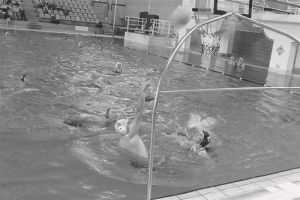History
There appears to be no clearly defined origin of Water Basketball. Wikipedia claims:
Water basketball is a water sport which mixes the rules of basketball and water polo. Developed and promoted by Italian teacher Francesco Rizzuto in 1986, it is played in a swimming pool. Teams of five players each must shoot at the goal with a ball within a certain time after gaining possession.
In the USA, Brazil, and Europe, some amatorial matches are organized to develop this sport.
In 2005, the Italian Federation of Basketball recognized it as a form of basketball.
In the Netherlands, people have been playing water basketball (known there as waterbasketbal) since the 1970s. In the Netherlands it was played by people with a handicap. Besides regular tournaments, they also organize a national championship where the best teams compete for the official Dutch Waterbasketbal championship title.
In Tasmania, Water Basketball first started in September 2003 with a demonstration game between two teams made up of Hobart Chargers, Hobart Hurricanes, Tassie Devils football team and the Tassie Tigers cricket team. The most well known player to play in this team was future test cricketer, Shane Watson.
The first competition began in October 2003 with teams made up of basketball – and water polo players, and some non-associated players. This concept lasted for two seasons.
 |
In early 2004 the key (offence/defense area) was introduced, for player safety as the game evolved. In the first year notable players were Wes Roach, and Garth Slade who started to develop a set of agreed rules, initially based on many aspects of water polo. Martin Svensen, working with Melissa Carlton, also introduced the idea that the contact in the game be reduced to allow younger people to play who found water polo too physical, and also to encourage a mixed gender aspect to the game. |
By mid 2004 there were only 8 players and most of those made up the Water Basketball Board initiated by Melissa Carlton. The two team competition between the teams Blue Fish and White Fish quickly expanded to four teams. In the winter roster of 2004 quarters were lengthened from 6 to 8 minutes. There was a roster but still without a “premiership”.
A significant change took place in September of 2004 when the well-organized Ducks Out of Water joined the roster. Their playing style forced other teams to become more organized, and so the Sharks, Lobsters, Octopuses and Blue Steel were formed. The first Grand Final was played between Octopuses and Lobsters, which the Octopuses won 22-21. Best player of that Grand Final was Stuart Wilde.
In 2005 there were 4 short seasons which were dominated by two teams Sharks and Ducks Out of Water. Brothers from the Poolside and Shark Fin Soup made their debut in 2005 with the Sharks winning the Summer, Autumn and Winter rosters. Finally in December 2005 Ducks Out of Water won their first and only title and revenge over the Sharks.
With a new year dawning a few things changed. Most significantly the height of the goal was lifted to 1.70 metres and statistics were introduced. New teams for that year were The Nuts, Frank and Beans, Dolphins, Prime Plan and Just a Keg.
Two divisions for the finals as well as Splashball for kids were introduced. The most dominant team for that year was Brothers from the Poolside who topped the ladder for Season one and two and finished second in season three. Brothers won one title but were beaten by Shark Fin Soup in season two and by the Nuts in season three.
In 2007 the game plateaued with the 12 teams for that year and due to the number of teams since then each year was limited to two seasons, played from Feb-Jun and Jul-Dec. The top four teams that year were Sharks, Brothers, Nuts and Shark Fin Soup. Nuts and Brothers both won one title each.
The Nuts dominated the competition during 2008-2010, winning 5 grand Finals in a row, forcing teams to develop their tactics and positioning, resulting in a further evolution of the game featuring a faster pace, new strategies and rule changes triggered by competition pushing the boundaries.
In 2011 the Social Competition was introduced, taking place between the two regular seasons. The Social Competition mixes existing and new players into temporary teams for a short tournament (ranging from 3-5 weeks). Existing players get to mix with players from other teams and new players are given a great opportunity to give this unique sport a try while being assisted by more experienced players.
During 2013-15 the water basketball board successfully reduced occurrences of teams forfeiting due to low numbers and focused on maintaining a solid core of at least 8 teams and ensuring a strong ongoing commitment to a program that has evolved competitively and resulted in many new friendships throughout the years.

















